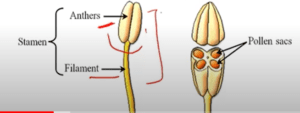Curriculum
- 1 Section
- 5 Lessons
- 10 Weeks
- Biology Sexual Reproduction In Plant Class 125
Biology Sexual Reproduction In Plant Class 12 Part 1
WHAT IS FLOWER ?
- Flowers are morphologically and embryo logically marvels and the sites of sexual reproduction in angiosperm.
- A typical angiosperm flower consists of whorls of floral appendages attached on the receptacle:
- 1.Calyx- consist of sepals – non-essential
- 2.Coralla – consist of petals – non-essential
- 3.Androecium – consist of stamen -essential
- 4.Gynoecium consist of carpel – essential
PRE-FERTILIZATION – STRUCTURE AND EVENTS
MALE PART- ANDROECIUM
FEMALE PART- GYNOECIUM
STAMEN, MICROSPORANGIUM, POLLEN GRAINS
A typical stamen consist of two parts:
- Anther-it is a terminal bilobed structure.
- Filament – it is a long and slender stalk. Its proximal end remains attached to thalamus or the petal of the flower.

STRUCTURE OF TYPICAL ANTHER
- A typical anther is bilobed. The two anther lobes are separated by a groove in front and are attached to each other by a vascular sterile tissue called connective.
- Each anther is four sidedtetragonal located at corners, two in each lobe, hence a mature anther is tetrasporangium.
- Microsporangium forms pollen sacs which on maturity become filledwith pollen grains.
STRUCTURE OF MICROSPORANGIUM
Anther wall consist of four layers:-
- Epidermis – Outermost, single layered and protective in fuction.
- Endothecium – Cells of this layer have a- cellulosic fibrous bands arising from inner tangential wall which help in dehiscence of anther due to their hygroscopic nature.
- Middle layer – It is 1-3 layered. It degenerates at maturity.
- Tapetum – it is the inner most layer of anther wall which surrounds the sporogenous tissue.
MICROSPOROGENESIS :-It is the process of formation of microspore from PMC (Pollen Mother Cells).
As development occurs in the anther, the sporogenous tissue undergoes meiosis to form microspore tetrad. Each cell of sporogenous tissue has capacity to give rise to a tetrad. Hence, each cell is a potential pollen or PMC.
As the anther matures, the microspores get detached from each other and develop into pollen grains. tissue occupies the center of each microsporangium.
SPOROGENOUS TISSUE:– when the anther is young, a group of compactly arranged homogenous cells called the sporogenous.
Pollen grains
•Represent the male gamete and are spherical, having a two-layered wall:
- Exine (outer) – Hard layer made of sporopollenin, which is extremely resistant and can withstand high temperatures, acidic and alkaline conditions, and enzymes
- Intine (inner) – Thin and continuous layer made up of cellulose and pectin
•Mature pollen grain contains two cells:
- Vegetative cell – Large with irregular nucleus, contains food reserves
- Generative cell – Small and floats in the cytoplasm of the vegetative cell
•In 60% of the angiosperms, pollen grains are shed at 2-celled stage while in others generative cell undergoes mitosis to form two male gametes (3-celled stage).
•The viability of pollen grains after they are shed depends upon temperature and humidity. It ranges from 30 minutes to few months.
Pollen allergy
Pollen is one of the most common causes of allergies in the United States. Pollen is a very fine powder produced by trees, flowers, grasses, and weeds in order to fertilize other plants of the same species. Many people have an adverse immune response when they breathe in pollen. The immune system normally defends the body against harmful invaders, such as viruses and bacteria, to ward off illnesses. In
people with pollen allergies, the immune system mistakenly identifies the harmless pollen as a dangerous intruder and begins to produce chemicals to fight against the pollen. This is known as an allergic reaction, and the specific type of pollen that causes it is known as an allergen. The reaction leads to numerous irritating symptoms, such as sneezing, stuffy nose, and watery eyes.
Pollen product
The use of bee pollen increased during the late 1970s, following testimonials by athletes that supplementation with this product increased stamina and improved athletic ability. Bee pollen has been used in certain cultures for thousands of years, but has become increasingly popular over recent years and recognized for its potential health benefits. It has been traditionally used for a variety of purposes, including relief of constipation; treatment of prostatic conditions, such as prostatitis, benign prostatic hyperplasia, and prostate cancer; wound healing; and for its proposed antioxidant action.
Pollen viability
Pollen viability refers to the ability of the pollen to perform its function of delivering male gametes to the embryo sac. Pollen viability varies between minutes and years, and which primarily depends on the taxonomic status of the plant and on the abiotic environmental conditions. In order to maintain the viability and fertilizing ability of the pollen for a long period of time special storage conditions are needed.